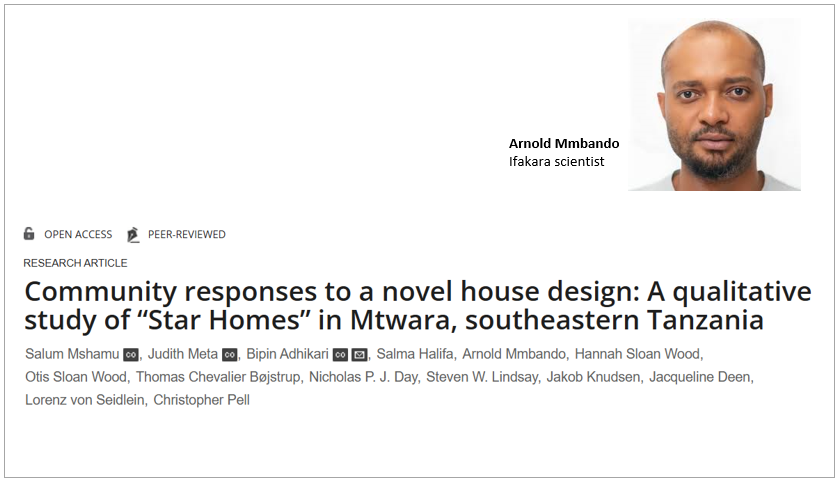
STAR HOMES: Novel design test results show promise, despite challenges

An ambitious housing project is making waves in rural Tanzania, offering new hope in the fight against diseases like malaria, respiratory infections, and diarrhoea. Known as Star Homes, these innovative houses are not only helping prevent these diseases but also winning the hearts of local communities, according to two recent scientific studies.
But how did this bold idea work in practice?
In the southern region of Mtwara, scientists, architects, and public health experts came together between 2021 and 2023 to reimagine what a healthy home could look like. The result? Star Homes—specially designed houses built with durable materials and equipped with clean water, electricity, and modern toilets. A total of 110 Star Homes were built across 60 villages in Mtwara and handed over to selected families.
Fewer mosquitoes, healthier lives
One of the studies, published on The Lancet Planetary Health, presents compelling evidence of the homes' impact. Researchers conducted a household trial in Mtwara to determine whether the new designs led to fewer malaria-carrying mosquitoes indoors. The findings were clear: Star Homes had significantly fewer mosquitoes compared to traditional houses, demonstrating a real potential to reduce malaria transmission.
"Our study demonstrates that the novel star home design, featuring integrated mosquito screening, effectively reduces the entry of mosquitoes," remarked the scientists. "These findings add to the growing evidence supporting house screening as a valuable supplementary strategy for the control of malaria, and are supported by WHO's Global Vector Control Response 2017–30."
Residents also noticed the difference and praised the improved ventilation, cleaner environment, and greater overall comfort. For many, moving into a Star Home wasn’t just about better health—it marked a major life upgrade.
Community acceptance is key
However, effectiveness alone doesn't guarantee long-term success - acceptance matters too. That’s where the second study, published in PLOS ONE, comes in. It explored how residents perceived their new homes over time. The feedback was largely positive, with most residents expressing a feeling of being safer, cleaner, and more hopeful. Children slept under stronger roofs, and parents spent fewer nights worrying about sickness.
Key features, resident feedback
Star Homes were designed to improve health outcomes with features like durable construction, insect-proofing, and clean toilets. Interviews with 37 Star Home residents, 21 control households (using traditional wattle-and-daub homes), six neighboring households, 17 community members, and six leaders revealed strong approval for the homes’ comfort, water access, and electricity. Residents reported better living conditions, with electricity aiding children’s education and sanitation reducing health risks.
The results showed promise: when you improve a home, you improve lives. And Star Homes may just offer a blueprint for how housing design can become a tool in the global health toolbox.
Not without challenges
Despite the enthusiasm, some challenges emerged. Residents raised concerns about cost, scale, and long-term sustainability of the houses. Poorly fitting doors allowed rainwater and insects to enter, undermining malaria prevention. Residents found kitchen stoves inefficient, and some avoided upstairs bedrooms due to cold floors or difficult stairs. These design flaws led to unintended uses, such as families sleeping downstairs, contrary to the homes’ health-focused layout.
The study found Star Homes sparked both admiration and envy in Mtwara. Neighbors praised the modern design, noting it elevated the community’s appearance. However, the limited distribution of free homes caused jealousy among some, straining community relations.
Researchers suggest better community engagement could mitigate such tensions and clarify the homes’ health benefits.
Designing for health, and people
The findings highlight the potential of health-focused housing but underscore the need for practical design adjustments. Recommendations include improving door seals, stove efficiency, and stair accessibility to align with residents’ lifestyles.
Both studies call for enhanced community sensitization to ensure people understand the health benefits of the homes and encourage broader acceptance and proper use of such interventions.
Promising model for reducing diseases
The Star Homes project offers a promising model for reducing childhood diseases through better housing, but its success hinges on addressing design and social challenges.
Researchers urge further studies to refine the approach, ensuring future iterations maximize health benefits for vulnerable communities like Mtwara. Together, these studies provide a blueprint for future public health strategies—ones that go beyond bed nets and medicine and tackle the root causes of disease by improving the environments people live in.
Ifakara’s Arnold Mmbando contributed to the study
Leading the charge in Tanzania was Arnold Mmbando, a researcher from the Ifakara Health Institute with contributions from Halfan Ngowo and Fredros Okumu – also from Ifakara. Other contributors included researchers from the Royal Danish Academy; Oxford University; The London School of Hygiene & Tropical Medicine; and Mahidol University in Thailand.
Read the Lancet Planetary Health publication here.
Read the PLOS One publication here.
